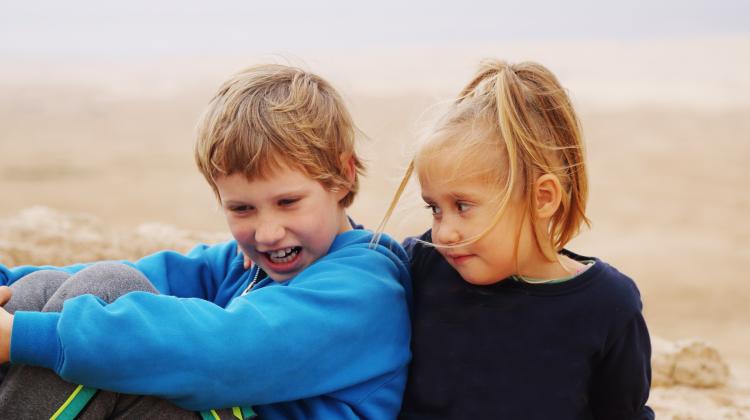Vocabulary of Polish 2-year-olds surveyed
 Photo: Fotolia
Photo: Fotolia
Two-year-old girls have a richer vocabulary than boys. Children usually learn nouns first: nouns account for about 65% vocabulary of Polish two-year-olds - the Jagiellonian University researchers have shown. Their study also shows that the vocabulary of Polish two-year-olds may be poorer than the vocabulary of their American peers.
The researchers used the Language Development Survey to determine the vocabulary of children between the 18th and 35th months. It is a list of 310 words, on which parents mark the words that children use spontaneously. An international study involving researchers from the Institute of Psychology of the Jagiellonian University was the first study conducted with the Polish version of this tool.
The results obtained by Polish children were compared with the results of American children.
"If we compare the number of words actually spoken by children, the results of Polish 2-year-olds are significantly lower than those of American children" - said one of the study\'s authors, Dr Marta Białecka-Pikul from the Institute of Psychology of the Jagiellonian University.
The survey showed that 18 percent Polish toddlers used less than 50 words, while only 8 percent American children had such a s small vocabulary was. 28 percent Polish children and only 12% American children used between 50 and 99 words. A similar proportion of children of both nations - about 15% - was in the range of 100 to 149 words. The largest amount of words, over 250, was spontaneously used by 16 percent Polish children and 28 percent American children.
In Poland - compared to the United States - there is a smaller group of two-year-olds who speak a lot of words and a larger group of children who speak few words. The results also suggest that it is much more difficult to learn to speak for two-year-olds from Poland than for children from the US.
According to Dr. Białecka-Pikul, there could be a number of reasons for this result. "First of all, the Polish language is difficult: there are cases, difficult phones. Secondly, the tool (in the Polish language version - PAP) was used for the first time and needs to be improved. Thirdly, Polish parents may be more onservative than the American ones when evaluating whether their child actually spontaneously uses the word. When this scale was used in other countries, it often turned out that children in the United States had higher scores" - said Dr. Białecka-Pikul.
"The study also confirmed that at the age of two, Polish girls had a richer vocabulary than the boys. This is also true for American children. In the following years, however, this difference disappears. This is because parents talk to girls more often, and they often use richer vocabulary" - explained Dr. Białecka-Pikul.
The study also showed a trend that also emerges in the results of other researchers. It turns out that in most languages small children learn nouns first, not verbs. "The child in its first vocabulary has primarily names of things" - the researcher told PAP.
Nouns accounted for nearly 65 percent vocabulary of Polish children. The situation was similar in the case of the language of two-year-olds from the US. Nouns accounted for nearly 70 percent words used by children. In both countries, verbs accounted for only about 8 percent vocabulary of children.
Some words are used particularly often by two-year-olds. In Polish, there are 23 words that more than 75% children use (for example "mom", "dad", "egg", "bear"). There are as many as 54 such words in English. Very popular word: "eye" is used by 71 percent Polish toddlers and 92 percent American two-year-olds; the word "shoes" is used by 64 percent Polish children compared to 91% American children; the word "juice" - by 61 percent Polish and 93 percent. American children.
Dr. Białecka-Pikul drew attention to the huge individual differences in Polish two-year-olds\' vocabulary. "On average, 2 year old children use 133 words, but the standard deviation is 90 words. 68 percent of the surveyed children are in the range of 43 to 223 words spoken. It\'s a huge difference whether the child speaks 43 or 223 words, and there are two-year-olds that go beyond that range" - noted the study author.
She emphasized that these differences should not weaken the vigilance of parents. If they have doubts concerning the vocabulary development of their child, they should not ignore these concerns, but respond quickly. "Vocabulary is a very important indicator of later development, it can be the basis for predicting that other difficulties may occur. Delay in language development is associated with delayed school readiness, dyslexia" - said Dr. Białecka-Pikul.
All the more valuable - she emphasised - is the construction of scales that allow to evaluate the child\'s vocabulary. Better still, if such a scale is widely used in the world, because then it allows for comparison. This is the case with the Language Development Survey, which already exists in Greek, Korean, Italian, Portuguese and now Polish.
According to Dr. Białecka-Pikul, the Language Development Survey has been translated into Polish, trying to keep as many words as possible from the original tool. The list of words was used to evaluate vocabulary was originally prepared on the basis of observations of American children. 42 words were changed in the Polish version of the scale (for example the word "comb" - "grzebień" in Polish - was replaced with a simpler "button" - "guzik" in Polish), but - to be able to compare vocabularies - the Polish word list was not built from scratch.
The researchers surveyed Polish 199 children and compared their results with the results of 422 children from the US. The study, funded by the National Science Centre, has been published in the Journal of Speech, Language, and Hearing Research.
PAP - Science and Scholarship in Poland, Ewelina Krajczyńska
ekr/ agt/ kap/
tr. RL
Przed dodaniem komentarza prosimy o zapoznanie z Regulaminem forum serwisu Nauka w Polsce.















